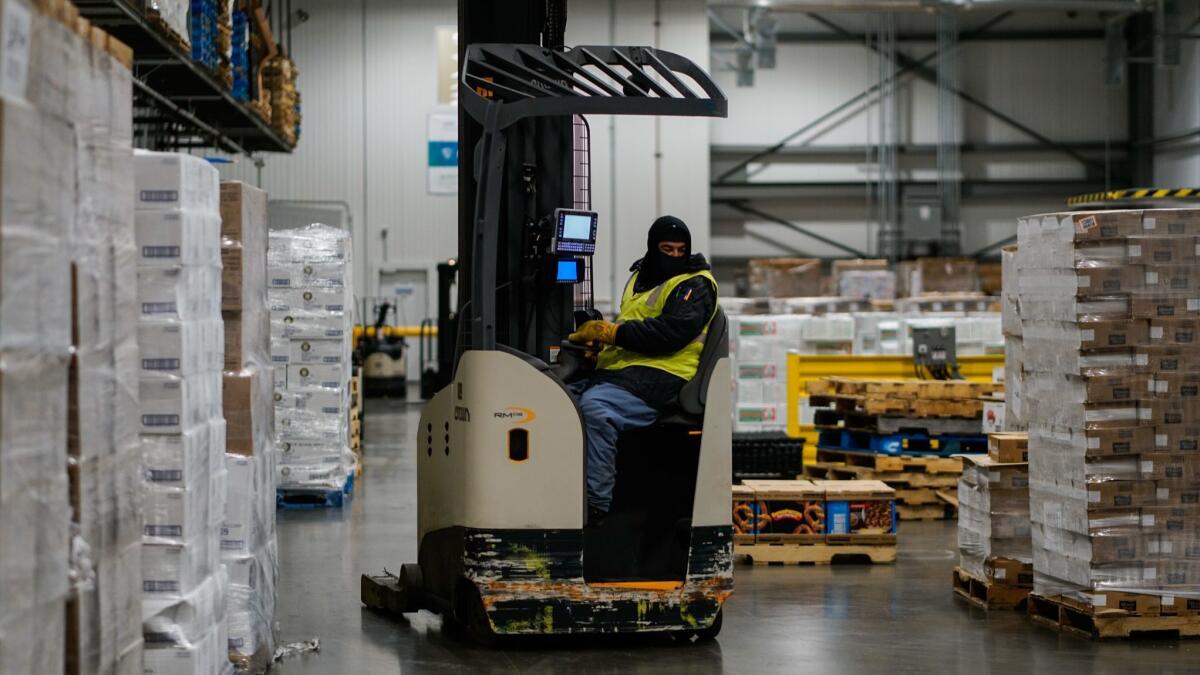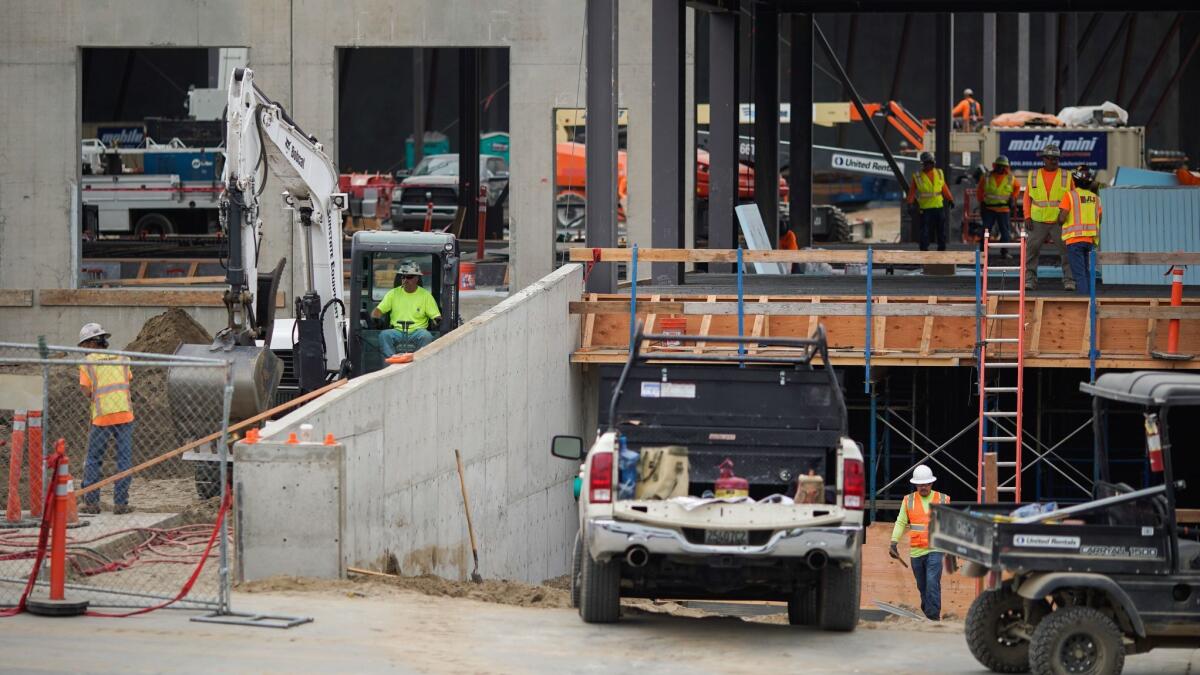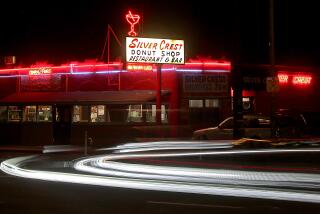All that online grocery shopping is causing a cold storage shortage

Deep in a Vernon warehouse, barrels of frozen mango puree from Mexico are stacked four stories high. Hams for Christmas are flash-frozen as June temperatures climb outside.
Inside this dimly lit chamber of the Lineage Logistics warehouse, it is 10 degrees below zero — cold enough to stop a ballpoint pen from rolling out ink and send an ominous chill through the soles of visitors’ shoes.
For the record:
11:45 a.m. July 9, 2019An earlier version of this story stated that space in a typical 100,000-square-foot cold warehouse is about $150 a square foot per year. The correct figure is about $15 a square foot per year.
Lineage is the biggest player in the country’s cold storage industry, a business consumers seldom see but one that plays a crucial role in keeping edible fare fresh from the time it’s harvested until it reaches the kitchen fridge.
Now, changes in the way people shop have the “cold chain” scrambling to keep up. Consumers, particularly younger buyers, are turning more and more to online grocery shopping and prepared meal services, which means more refrigerated warehouses are needed to keep that stuff cold.
To keep pace, the country will need 100 million square feet of new cold storage warehouse space over the next five years, according to a report by real estate brokerage CBRE.
It’s a particularly hot corner in the mushrooming warehouse business, fed by demand from Amazon.com and other e-commerce operations, which have been growing at lightning speed. Last month, investment manager Blackstone Group said it would pay $18.7 billion to buy a network of U.S. industrial warehouses from Singapore-based GLP, reported to be the largest private real estate transaction in history.
California is the biggest user of cold storage, with an existing 16.5 million square feet, and Los Angeles will be one of the biggest beneficiaries of the coming boom in cold storage construction because of its large population and position as a global transportation hub.
The ports of Los Angeles and Long Beach, the nation’s biggest container port complex, have more than doubled their refrigerated container capacity in recent years to address increasing import and export demand for fresh and frozen food products including meat, pork, poultry and animal feed, CBRE said.

Demand for cold storage is also being elevated by consumers’ growing aversion to chemical food preservatives. Refrigeration is a highly effective food preservative that can keep crops such as apples fresh-tasting for months without chemicals by slowing ripening and decay.
“Now, even hamburger buns need delivery through the cold chain,” said Spencer Levy, chairman of Americas research for CBRE. “You are seeing an increase there as demand for non-preservative food rises.”
One of the country’s largest agricultural regions is California’s Central Valley, where the cold chain starts in the field when heat-sensitive crops such as raspberries and cherries are quickly chilled in cold water or through other techniques before being transported in refrigerated trucks to cold storage facilities.
Online grocery shopping is still in its infancy compared with other retail categories, suggesting there is room for it to grow. Just 3% of U.S. grocery spending occurs online, while 20% of footwear and 40% of electronics spending occurs online.
The desire for online shopping is accelerating for both prepared meals and groceries, said Art Rasmussen, a CBRE broker who specializes in cold storage facility sales and leases.
“We are turning to e-commerce for convenience, making consumption decisions for dinner at 4 or 5 and having it on the table at 6 or 7,” Rasmussen said. “That’s a trend that’s not going to stop.”
Millennials, who are in their 20s and 30s, take it for granted that they can get what they want with a few mouse clicks.
“Part of their lifestyle is quick delivery response to demand,” Rasmussen said. “Once that becomes a learned trait, it is very difficult to reverse.”
Not that anyone seems to be trying to roll back such expectations, even among baby boomers who grew up waiting weeks for mail-order goods and for the most part have yet to embrace online grocery shopping.
Although the baby boom generation isn’t a big user of online grocery shopping today, this age group — with 10,000 people retiring every day in the U.S. — is expected to use online grocery shopping more as the technology and experience improve, CBRE said.
In addition, decreasing mobility that comes with age is bound to make home grocery delivery more appealing.
Demand for refrigerated warehouse space is also benefiting from the food industry’s increasing propensity to outsource the storage and distribution of their products to refrigerated warehouse providers such as Lineage and United States Cold Storage.

Historically, the food industry handled these activities in-house, but rising costs of operation, including increasingly complex and expensive technological systems, have made outsourcing more attractive, even though cold storage doesn’t come cheap.
Space in a typical 100,000-square-foot cold warehouse is about $15 a square foot per year, CBRE said, roughly triple the rent of a standard warehouse.
Lineage Logistics’ Vernon warehouse is one of its smaller facilities with a capacity of about 30 million pounds of goods, serving as many as 1,000 trucks a day, company executive Kevin Marchetti said. To keep up with demand, the company is working on a big expansion of the warehouse.
Inside, tall doors pop open and close quickly for bundled-up workers zooming about on forklifts equipped with cameras that show operators what they are loading or unloading from high in the shelves.
Visitors are assigned insulated coats and admonished to “stay close” to their guide in the frigid chambers.
Chilled space is rented to clients and includes fare such as ice cream, pizzas, peas and poultry. Or as Marchetti put it: “Anything you see in the frozen aisle or perishable section of your grocery store.”







